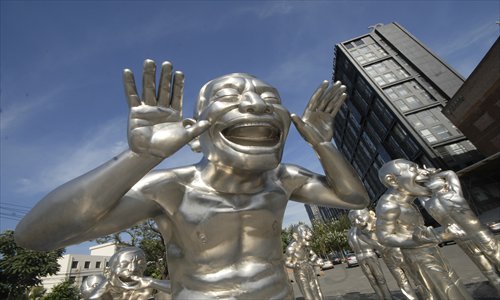
Sculptures by Chinese artist Yue Minjun out the front of the Today Art Museum, Chaoyang district. Photo: CFP
When talking about modern art in Beijing, the 798 Art Zone founded in 2001 is generally recognized as the city's iconic landmark. Situated in a former industrial area in Chaoyang district, the past decade has seen the art zone become a well-known travel destination, as well as prosperous market for cultural consumption.
However, that could change this year as urban art in Beijing embraces a new age, with vast funds poised to flow into the local cultural industry. The city is bracing for an expansion of art zones and he emergence of new galleries conspicuously reforming the capital's artistic map.
Expanding art zones
The capital on Beijing's "art map" is 798. The fast-developing art zone located awkwardly away from the city center attracts a swathe of international and homegrown artists, and is home to art institutes including the Ullens Center for Contemporary Art (UCCA), Iberia Center for Contemporary Art (ICCA) and Pace Beijing. The presence of these institutes not only enriches the cultural diversity of the city, but also offers a window into contemporary art for Beijing residents.
Spanning more than 5,000 square meters, the UCCA is the largest art institute within 798. However, that record is destined to become history by the end of 2012, with the Minsheng Art Museum slated to eclipse it.
He Juxing, director of the Minsheng Art Museum and manager of brand marketing at Minsheng Bank, said the aim of the project is to establish a world-class art gallery in Beijing. "The UK has the British Museum and Tate Britain, France has the Louvre and Pompidou Center, New York has the Metropolis and Museum of Modern Art, but what does Beijing have for modern art? That's what we are working on," said He.
He revealed that the museum alone will occupy 30,000 square meters area, just under half the size of the Louvre. "A 10,000-square-meter permanent exhibition hall will be built to display modern art. The first exhibits on display will be all Chinese artworks. Within the next decade, we will add artworks from international artists and even the proportion of Chinese-to-foreign artworks to 50-50," said He. "We hope this exhibition hall will offer Chinese people a deeper understanding of modern art."
He ambitiously added that the museum will also provide a "challenging exhibition hall" spanning 10,000 square meters for bold, daring artists whose artworks can't be exhibited elsewhere because of their "outrageous creativity."
Another 10,000-square-meter hall will exhibit up to 30 artists' works, with the selection of artists to continually rotate to ensure fresh, international appeal.
As the museum's director and main investor, He expressed his hope of converting the museum into a forum for international artistic communication.
"I hope our museum can become an art gallery for ordinary people as well," he said. "The day people walk into our museum at ease with their surrounds will mark the day art becomes part of common people's life."
Mixing art and business
Despite art zones including 798 and Songzhuang holding a strategic foothold in urban areas, the central business district (CBD) looms as one of the most promising areas to bring art to the people. The China International Exhibition Center (CIEC) in Sanyuanqiao near the Northeast Third Ring Road is also building its own art zone.
Yang Chunqiao, director of the CIEC art center, hinted that the art zone under construction will cover a staggering 100,000 square meters once complete.
Yang described the project as "a multi-function art zone" that would offer more than just art to its visitors. "The CIEC Art Center will be a management base, art gallery, forum, trade and media center, as well as an art foundation," Yang emphasized. "We predict that annual revenue will reach 10 billion yuan ($6 billion)."
Another art zone in the CBD is the 22 International Art Plaza. Situated on the on the north-south axis between SOHO Modern City and the China World Trade Center, it also aims to attract investors with its selection of art for sale. Zhang Baoquan, chief executive of Antaeus Group and an investor in the International Art Plaza program, said the disposable income of residents in the CBD makes it the ideal location for an art zone.
Risk of overheating
The expanding "art map" of Beijing might herald a cultural renaissance in the capital, but experts warn that it's a process that requires strict supervision.
Independent curator and art critic Gu Zhenqing described the current expansion of art zones as "overheated."
"The government has made promoting culture a priority through its policy, and helped spearhead many art projects," Gu noted. "However, many enterprises are taking advantage of this policy to acquire cheap land and serve their own business interests."
Ecology of art is not only determined by how much land art zones occupy but also free artistic expression, Gu added. Many of the soon-to-be built art galleries and institutes lack suitable collections of artworks to exhibit, raising concerns over what they can contribute to Beijing's art scene and, more importantly, how they will attract visitors.
Professor Jin Yuanpu, director of the Cultural Creative Industries Studies Center at Renmin University, pointed out that cultural consumption is an essential component of improving the arts scene.
"The government's policy of promoting the cultural industry is being abused to a certain extent. This reflects anxiety linked to securing quick profits, and subsequently has a negative influence on the cultural industry," Jin said. "As the economy continues to develop, Chinese people will have more money to consume cultural products. However, their spending habits need to be guided."

Copyright ©1999-2011 Chinanews.com. All rights reserved.
Reproduction in whole or in part without permission is prohibited.